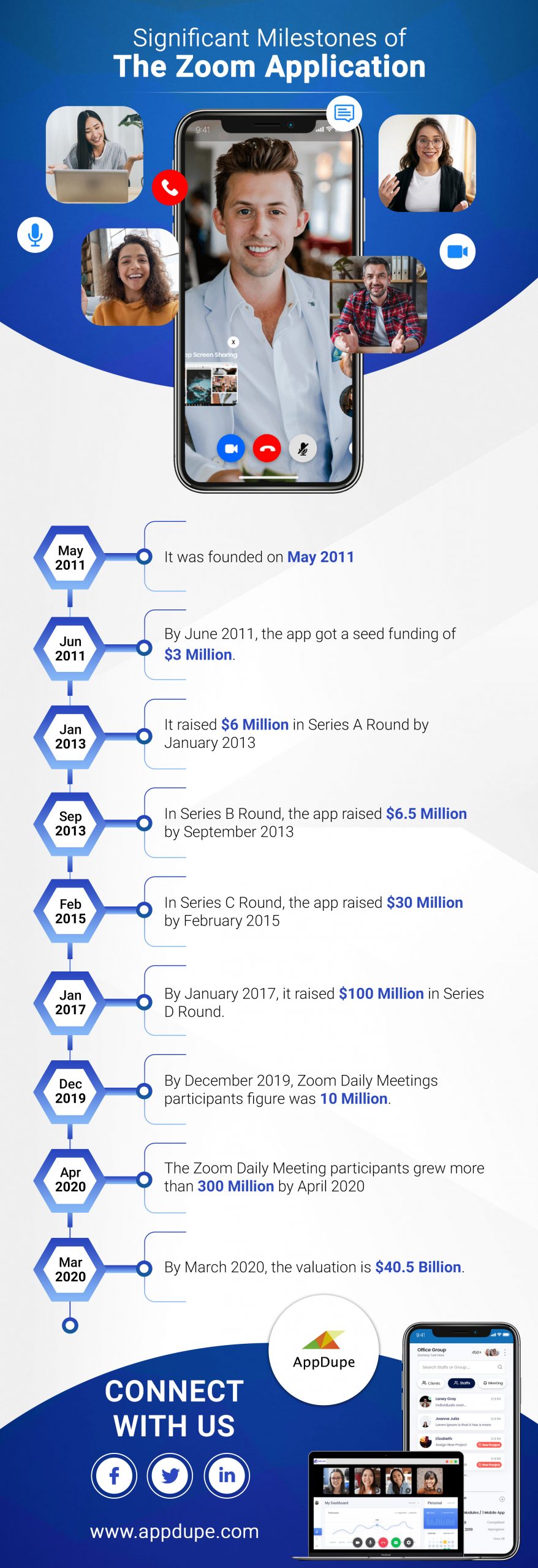
There is this talk of the town about so many things nowadays that mainly consists of social distancing, coronavirus, and remote working. And the one who is fueling these talks is the mobile apps.
If the apps that are of significant installation rate or usage has to be mentioned, without missing a single beat, we can say that they are the video chat apps.Turning the term social distancing into distant socializing is a significant attraction factor, and one app that has the best contribution to this is Zoom application. By every passing day, the fortune it makes is ample proof if you choose not to believe.
Zoom has registered approximately 131 million new installs in the April month that is almost 60 times the rate when compared to April 2019, according to Sensortower. Apart from this astounding stats, it had also become the most-downloaded non-game app around the world for April 2020, by leaving behind the big giants like TikTok and Facebook.
Now, several entrepreneurs want to get hold of this and replicate the success. So many are choosing to develop a Zoom Clone app development. So, they want to know about the business and revenue models. Hoping that you are one of them, let’s get started with the details by analyzing
Significant milestones of the Zoom application
Here are some crucial steps that led the application to its booming success

READY TO LAUNCH AN APP LIKE ZOOM? LET’S DISCUSS!
As we all know, Zoom is a video-conferencing application that is exclusively designed for business use. The app targets businesses of all sizes, including industries that need video conferencing solutions. It has thus established an important place for itself by providing users with an app exhibiting an incredible performance. The application is being used by more than 300,000 organizations, including prominent users like SolarCity, Arista, and UCLA. Recently, the app has joined hands with Amazon’s Echo to provide unlimited video calling features to all its users.
Not to forget that the primary reason for its success is the focus. The Zoom’s guide was on developing the advanced features for the app as per the feedback provided by the users. Now, this is one great lesson you can keep up with your app’s development too.
Now, let’s stop with the standard model and get into the subject at our hands- Zoom Clone application.
What is the business model of Zoom Clone application?
The users are allowed to access the app on several app and web platforms like iOS, Android, PC, Mac, and Linux.
The communication in the app can be of any mode such as chat, audio, video, or mix of all three, which also happens to be the value proposition of the software. It acts as a one-stop destination for any collaboration, be it group meetings, video conferencing, chatting or just calling.
The working of the Zoom Clone app is using the Freemium Business Model. There are four different membership plans, in which one of them is a free plan. Any regular user can make use of the open-plan, as it lets the user have video conferences for 40 minutes with up to 100 members.
This doesn’t mean that the app is free to use. Instead, users have to pay for every unique feature they would like to have in the app. Example, to enable the ability to add 100+ participants, to increase the duration of the meeting and also to integrate any other services.
The features of Zoom Clone involve one-on-one meetings, screen sharing, and group conferences/meetings, where users can avail the options of meeting like one-on-one or large groups, and they can also share their screens to see what the other participants are doing. But the global adoption is mainly fueled by just two products, which are, chats and Zoom Clone meetings.
Users can attend the meetings using an internet browser, desktop, and mobile apps. As an extension to the Meeting product of the Zoom Clone, users can chat with the other users, make groups or can also share documents.
Usage of other plans except for the Freemium model, allows organizations to use hardware such as a computer, microphone, camera, and some other components for virtual meetings planning. These solutions are exclusively for large-scale businesses which are in need to collaborate with other companies.
On the whole, the freemium model is what helps in increase of the adoption rate, and with non-stop updation, it would be the best in the video conferencing industry and an excellent fit for present time needs.
Revenue model
The revenue model of the Zoom Clone mainly relies on the subscription plan it offers. The subscription plan can be provided in four categories depending on the choice. Every model gives the users an option to increase the number of hosts and participants, the time-limit and also the addition of some hardware. Each would come at different pricing per month.
Another revenue model, as a suggestion is the advertisement charge. You can charge from the third-party advertisers if they wish to post any advertisements on your platform.
Tips to have incredible success with the Zoom Clone application
Be user-centric
The priority for the customers is what drives any app forward. Dreaming about overnight success or fast publicity can never happen in real life. Keep your users happy and make their experience better. Success would knock on your door.
Grow from feedback
To develop a world class product is to grow from your mistakes. So, take the feedback in a positive sense and improvise your product.
Believe your brain
A thumb rule that can be set for every startup is, either solve a huge problem or solve the already solved problems in a more effective way.
Conclusion
If you want to create a Zoom Clone for business, then pull your socks now. There might be a lot of players in the market, but you can conquer the market by investing in your ideas. There are still many ways to win. So get started with the race now!
Want to develop a leading app like Zoom? Get our white-label Zoom Clone app now!

Marketing is my soul mate and writing is my side kick. Using my writing skills to share the knowledge of app development and upcoming technologies.









Профессиональный сервисный центр по ремонту бытовой техники с выездом на дом.
Мы предлагаем:сервисные центры в москве
Наши мастера оперативно устранят неисправности вашего устройства в сервисе или с выездом на дом!
Профессиональный сервисный центр по ремонту техники в Барнауле.
Мы предлагаем: Сколько стоит отремонтировать стиральную машину Gorenje
Наши мастера оперативно устранят неисправности вашего устройства в сервисе или с выездом на дом!
Предлагаем услуги профессиональных инженеров офицальной мастерской.
Еслли вы искали ремонт холодильников gorenje, можете посмотреть на сайте: ремонт холодильников gorenje адреса
Наши мастера оперативно устранят неисправности вашего устройства в сервисе или с выездом на дом!
Предлагаем услуги профессиональных инженеров офицальной мастерской.
Еслли вы искали ремонт кофемашин philips сервис, можете посмотреть на сайте: ремонт кофемашин philips адреса
Наши мастера оперативно устранят неисправности вашего устройства в сервисе или с выездом на дом!
Прелагаю посетить популярный сайт, на котором можно найти информацию на все случаи жизни.
Много полезной и интересной информации в статье: Музыкальный бизнес – основы
Подписывайтесь и получайте постоянные обновления. Пользуйтесь сервисами, делитесь информацией, находите дрeзей!
339686 972053Id need to have to consult you here. Which isnt some thing Which i do! I enjoy reading a post that can make individuals feel. Also, appreciate your permitting me to comment! 356197
828501 687363A actually fascinating read, I might effectively not agree completely, but you do make some quite legitimate factors. 825723
Профессиональный сервисный центр по ремонту техники.
Мы предлагаем: Ремонт бесперебойников в Ростове на Дону
Наши мастера оперативно устранят неисправности вашего устройства в сервисе или с выездом на дом!
117626 254969But wanna say that this is invaluable , Thanks for taking your time to write this. 825236
Прелагаю посетить популярный сайт, на котором можно найти информацию на все случаи жизни.
Много полезных и интересных статей в категории: Строительство
Подписывайтесь и получайте постоянные обновления. Пользуйтесь сервисами, делитесь информацией, находите дрeзей!
518373 782911I used to be recommended this web web site by my cousin. Im no longer positive whether this put up is written by way of him as nobody else know such exact approximately my difficulty. You are remarkable! Thank you! 56799